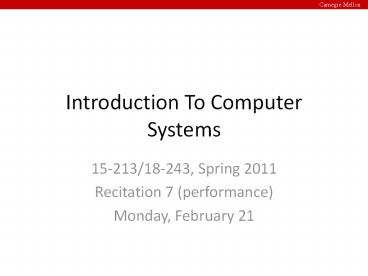Introduction To Computer Systems - PowerPoint PPT Presentation
Title:
Introduction To Computer Systems
Description:
Agenda Performance review Program optimization Memory hierarchy and caches Carnegie ... Loop Unrolling Other Techniques Caches Cache Misses Locality Memory ... – PowerPoint PPT presentation
Number of Views:86
Avg rating:3.0/5.0
Title: Introduction To Computer Systems
1
Introduction To Computer Systems
Carnegie Mellon
- 15-213/18-243, Spring 2011
- Recitation 7 (performance)
- Monday, February 21
2
Agenda
Carnegie Mellon
- Performance review
- Program optimization
- Memory hierarchy and caches
3
Performance Review
Carnegie Mellon
- Program optimization
- Efficient programs result from
- Good algorithms and data structures
- Code that the compiler can effectively optimize
and turn into efficient executable - The topic of program optimization relates to the
second
4
Performance Review (cont)
Carnegie Mellon
- Modern compilers use sophisticated techniques to
optimize programs - However,
- Their ability to understand code is limited
- They are conservative
- Programmer can greatly influence compilers
ability to optimize
5
Optimization Blockers
Carnegie Mellon
- Procedure calls
- Compilers ability to perform inter-procedural
optimization is limited - Solution replace call by procedure body
- Can result in much faster programs
- Inlining and macros can help preserve modularity
- Loop invariants
- Expression that do not change in loop body
- Solution code motion
6
Optimization Blockers (cont)
Carnegie Mellon
- Memory aliasing
- Accessing memory can have side effects difficult
for the compiler to analyze (e.g., aliasing) - Solution scalar replacement
- Copy elements into temporary variables, operate,
then store result back - Particularly important if memory references are
in innermost loop
7
Loop Unrolling
Carnegie Mellon
- A technique for reducing loop overhead
- Perform more data operations in single iteration
- Resulting program has fewer iterations, which
translates into fewer condition checks and jumps - Enables more aggressive scheduling of loops
- However, too much unrolling can be bad
- Results in larger code
- Code may not fit in instruction cache
8
Other Techniques
Carnegie Mellon
- Out of order processing
- Branch prediction
- Less crucial in this class
9
Caches
Carnegie Mellon
- Definition
- Memory with short access time
- Used for storage of frequently or recently used
instructions or data - Performance metrics
- Hit rate
- Miss rate (commonly used)
- Miss penalty
10
Cache Misses
Carnegie Mellon
- Types of misses
- Compulsory due to cold cache (happens at
beginning) - Conflict When referenced data maps to the same
block - Capacity when working set is larger than cache
11
Locality
Carnegie Mellon
- Reason why caches work
- Temporal locality
- Programs tend to use the same data and
instructions over and over - Spatial locality
- Program tend to use data and instructions with
addresses near to those they have recently used
12
Memory Hierarchy
Carnegie Mellon
13
Cache Miss Analysis Exercise
Carnegie Mellon
- Assume
- Cache blocks are 16-byte
- Only memory accesses are to the entries of grid
- Determine the cache performance of the following
- struct algae_position
- int x
- int y
- struct algae_position_grid1616
- int total_x 0, total_y 0, i, j
- for (i 0 i lt 16 i)
- for (j 0 j lt 16 j)
- total_x gridij.x
- for (i 0 i lt 16 i)
- for (j 0 j lt 16 j)
- total_y gridij.y
14
Techniques for Increasing Locality
Carnegie Mellon
- Rearranging loops (increases spatial locality)
- Analyze the cache miss rate for the following
- Assume 32-byte lines, array elements are doubles
void ijk(A, B, C, n) int i, j, k
double sum for (i 0 i lt n i)
for (j 0 j lt n j) sum 0.0
for (k 0 k lt n k)
sum AikBkj Cij
sum
void kij(A, B, C, n) int i, j, k
double r for (k 0 klt n k) for
(i 0 i lt n i) r Aik
for (j 0 j lt n j)
Cij rBkj
15
Techniques for Increasing Locality (cont)
Carnegie Mellon
- Blocking (increases temporal locality)
- Analyze the cache miss rate for the following
- Assume 32-byte lines, array elements are doubles
void naive(A, B, C, n) int i, j, k
for (i 0 i lt n i) for (j 0 j lt
n j) for (k 0 k lt n k)
Cij AikBkj
void blocking (A, B, C, n, b) int i, j,
k, i1, j1, k1 for (i 0 i lt n i b)
for (j 0 j lt n j b) for (k 0 k lt
n k b) for (i1 i i1 lt (i b)
i1) for (j1 j j1 lt (j b) j1)
for (k1 k k1 lt (k b) k1)
ci1j1 Ai1k1Bk1j1
16
Questions?
Carnegie Mellon
- Program optimization
- Writing friendly cache code
- Cache lab































